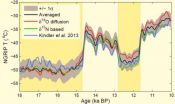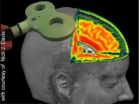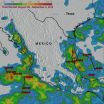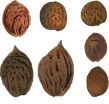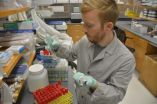(Press-News.org) PHILADELPHIA - Over the years researchers have made tremendous strides in the understanding and treatment of cancer by searching genomes for links between genetic alterations and disease.
Most of those studies have focused on the portion of the human genome that encodes protein – a fraction that accounts for just 2 percent of human DNA overall. Yet the vast majority of genomic alterations associated with cancer lie outside protein-coding genes, in what traditionally has been derided as "junk DNA." Researchers today know that "junk DNA" is anything but – much of it is transcribed into RNA, for instance -- but finding meaning in those sequences remains a challenge.
Now a team led by Lin Zhang, PhD, research associate professor in the Department of Obstetrics and Gynecology at the Perelman School of Medicine at the University of Pennsylvania, has mined those sequences to identify a non-protein-coding RNA whose expression is linked to ovarian cancer. The study is published online in this week in Cancer Cell.
Supported by the Basser Research Center for BRCA in Penn's Abramson Cancer Center, Zhang and his team built a DNA copy number profile for nearly 14,000 long non-coding RNA, or lncRNAs, across 12 cancer types, including ovarian and breast cancers -- the two major BRCA-related cancers. They found that the number of copies of lncRNA genes on a chromosome consistently change in 12 different cancer types and lncRNA genes are widely expressed in cancer cells.
What these non-protein-coding RNAs do is still relatively unknown. However, given their vast numbers in the human genome, researchers believe that they likely play important roles in normal human development and response to disease.
Using clinical, genetic, and gene expression data as filters to distinguish genes whose copy number alteration causes cancer from those for whom copy number changes are incidental, the team whittled down their list from 14,000 to a more manageable number, each of which they systematically tested using genetic experiments in animals.
Of the 37 lncRNAs the team fully tested, one, which they called focally amplified lncRNA on chromosome 1, or FAL1, had all the makings of an RNA oncogene. FAL1 is one of only a handful of lncRNAs to be linked to cancer to date. This knowledge is being applied for clinical applications. For example, FAL1 expression may be a biomarker of BRCA-related cancer prognosis and the basis of new anti-cancer therapeutics. As proof-of-principle of the potential efficacy, Zhang's team grew human ovarian tumors in immunocompromised mice, then injected short-interfering RNAs to block the tumors' growth using RNA interference against FAL1. The tumors in treated animals shrank over the course of the experiment, while tumors in control animals continued to grow.
Personalized Diagnostics
FAL1 is overexpressed in ovarian and breast cancer samples. Blocking the activity of the gene via RNA interference reduces cancer cells' growth, while overexpressing it in normal cells increases their growth. When the team assessed FAL1 expression in human ovarian cancer samples, they found that high FAL1 expression tended to correlate with poor clinical prognosis.
"This is the first genome-wide study to use bioinformatics and clinical information to systematically identify one lncRNA, which we found to be oncogenic," Zhang says.
Finally, the team investigated what FAL1 does. They looked for proteins that associate with the FAL1 RNA and identified a protein called BMI1, a member of a gene regulatory complex called PRC1. In the absence of FAL1, the BMI1 protein is unstable. FAL1 RNA stabilizes BMI1, which in turn acts to turn down the expression of several hundred other genes. One of those downregulated genes encodes a tumor suppressor protein called p21.
These data, Zhang explains, suggest a molecular mechanism in which amplification of the FAL1 gene in ovarian cancer causes a surfeit of FAL1 RNA. That leads to enhanced stability of the BMI1 protein and downregulation of p21 and ultimately, unrestrained cell growth.
FAL1 expression may be able to serve as a biomarker of BRCA-related cancer prognosis, assuming these findings can be validated in other populations. But there also is the potential for new anti-cancer therapeutics, he says, whether those are therapeutics specifically targeting FAL1 RNA or small molecules that block the interaction between FAL1 and BMI1.
INFORMATION:
Other coauthors are Xaiwen Hu in Zhang laboratory, in collaboration with Penn investigators Hongzhe Li, Katherine Nathanson, Janos Tanyi, Kathleen Montone, and Chunsheng Li, as well as investigators from MD Anderson Cancer Center (Gordon Mills and Yiling Lu), Fox Chase Cancer Center (Jeff Boyd), University of Turin (Dionyssios Katsaros) and the Wistar Institute (Qihong Huang).
The study was also funded by the National Cancer Institute (R01CA142776, P50CA083638), the Ovarian Cancer Research Fund, the Breast Cancer Alliance, the Department of Defense, the Marsha Rivkin Center for Ovarian Cancer Research, and the China Scholarship Council.
Penn Medicine is one of the world's leading academic medical centers, dedicated to the related missions of medical education, biomedical research, and excellence in patient care. Penn Medicine consists of the Raymond and Ruth Perelman School of Medicine at the University of Pennsylvania (founded in 1765 as the nation's first medical school) and the University of Pennsylvania Health System, which together form a $4.3 billion enterprise.
The Perelman School of Medicine has been ranked among the top five medical schools in the United States for the past 17 years, according to U.S. News & World Report's survey of research-oriented medical schools. The School is consistently among the nation's top recipients of funding from the National Institutes of Health, with $392 million awarded in the 2013 fiscal year.
The University of Pennsylvania Health System's patient care facilities include: The Hospital of the University of Pennsylvania -- recognized as one of the nation's top "Honor Roll" hospitals by U.S. News & World Report; Penn Presbyterian Medical Center; Chester County Hospital; Penn Wissahickon Hospice; and Pennsylvania Hospital -- the nation's first hospital, founded in 1751. Additional affiliated inpatient care facilities and services throughout the Philadelphia region include Chestnut Hill Hospital and Good Shepherd Penn Partners, a partnership between Good Shepherd Rehabilitation Network and Penn Medicine.
Penn Medicine is committed to improving lives and health through a variety of community-based programs and activities. In fiscal year 2013, Penn Medicine provided $814 million to benefit our community.
Penn team finds ovarian cancer oncogene in 'junk DNA'
2014-09-06
ELSE PRESS RELEASES FROM THIS DATE:
Past temperature in Greenland adjusted
2014-09-05
One of the common perceptions about the climate is that the amount of carbon dioxide in the atmosphere, solar radiation and temperature follow each other – the more solar radiation and the more carbon dioxide, the hotter the temperature. This correlation is also seen in the Greenland ice cores that are drilled through the approximately three kilometer thick ice sheet. But during a period of several thousand years up until the last ice age ended approximately 12,000 years ago, this pattern did not fit and this was a mystery to researchers. Now researchers from the Niels ...
WHO-commissioned report on e-cigarettes misleading, say experts
2014-09-05
World leading tobacco experts argue that a recently published World Health Organization (WHO)-commissioned review of evidence on e-cigarettes contains important errors, misinterpretations and misrepresentations putting policy-makers and the public in danger of foregoing the potential public health benefits of e-cigarettes.
The authors, writing today in the journal Addiction, analyse the WHO-commissioned Background Paper on E-cigarettes, which looks to have been influential in the recently published WHO report calling for greater regulation of e-cigarettes.
Professor ...
Visualizing plastic changes to the brain
2014-09-05
Tinnitus, migraine, epilepsy, depression, schizophrenia, Alzheimer's: all these are examples of diseases with neurological causes, the treatment and study of which is more and more frequently being carried out by means of magnetic stimulation of the brain. However, the method's precise mechanisms of action have not, as yet, been fully understood. The work group headed by PD Dr Dirk Jancke from the Institut für Neuroinformatik was the first to succeed in illustrating the neuronal effects of this treatment method with high-res images.
Painless Therapy
Transcranial magnetic ...
Harvard and Cornell researchers develop untethered, autonomous soft robot
2014-09-05
New Rochelle, NY, September 4, 2014--Imagine a non-rigid, shape-changing robot that walks on four "legs," can operate without the constraints of a tether, and can function in a snowstorm, move through puddles of water, and even withstand limited exposure to flames. Harvard advanced materials chemist George Whitesides, PhD and colleagues describe the mobile, autonomous robot they have created in Soft Robotics, a peer-reviewed journal from Mary Ann Liebert, Inc., publishers. The article is available on the Soft Robotics website.
In "A Resilient, Untethered Soft Robot," ...
Study: Viral infection in nose can trigger middle ear infection
2014-09-05
WINSTON-SALEM, N.C. – Sept. 5, 2014 – Middle ear infections, which affect more than 85 percent of children under the age of 3, can be triggered by a viral infection in the nose rather than solely by a bacterial infection, according to researchers at Wake Forest Baptist Medical Center.
By simultaneously infecting the nose with a flu virus and a bacterium that is one of the leading causes of ear infections in children, the researchers found that the flu virus inflamed the nasal tissue and significantly increased both the number of bacteria and their propensity to travel ...
NASA adds up heavy rainfall from Hurricane Norbert
2014-09-05
As Hurricane Norbert continued dropping heavy amounts of rainfall on Mexico's Baja California on September 5, NASA's TRMM satellite calculated the rain that had already fallen.
From its orbit in space, the Tropical Rainfall Measuring Mission or TRMM satellite has the capability of determining how much rainfall has occurred over given areas. Data from TRMM was compiled into a rainfall map that showed the rainfall generated from Tropical Storm Dolly and Hurricane Norbert from August 28 through September 4, 2014.
Tropical storm Dolly dissipated quickly after coming ashore ...
It's the pits: Ancient peach stones offer clues to fruit's origins
2014-09-05
Anyone who enjoys biting into a sweet, fleshy peach can now give thanks to the people who first began domesticating this fruit: Chinese farmers who lived 7,500 years ago.
In a study published today in PLOS ONE, Gary Crawford, a U of T Mississauga anthropology professor, and two Chinese colleagues propose that the domestic peaches enjoyed worldwide today can trace their ancestry back at least 7,500 years ago to the lower Yangtze River Valley in Southern China, not far from Shanghai. The study, headed by Yunfei Zheng from the Zhejiang Institute of Archeology in China's ...
Like weeds of the sea, 'brown tide' algae exploit nutrient-rich coastlines
2014-09-05
The sea-grass beds of Long Island's Great South Bay once teemed with shellfish. Clams, scallops and oysters filtered nutrients from the water and flushed money through the local economy. But three decades after the algae that cause brown tides first appeared here, much of the sea grass and the bounty it used to provide is gone.
Spring on eastern Long Island is now marked by dense blooms of Aureococcus anophagefferens, which turn estuaries like Great South Bay the color of mud and crowd out native sea grass and stunt or poison shellfish. For years, researchers have puzzled ...
Past sexual assault triples risk of future assault for college women
2014-09-05
BUFFALO, N.Y. -- Disturbing news for women on college campuses: a new study from the University at Buffalo Research Institute on Addictions (RIA) indicates that female college students who are victims of sexual assault are at a much higher risk of becoming victims again.
In fact, researchers found that college women who experienced severe sexual victimization were three times more likely than their peers to experience severe sexual victimization the following year.
RIA researchers followed nearly 1,000 college women, most age 18 to 21, over a five-year period, studying ...
Breast cancer specialist reports advance in treatment of triple-negative breast cancer
2014-09-05
William M. Sikov, a medical oncologist in the Breast Health Center and associate director for clinical research in the Program in Women's Oncology at Women & Infants Hospital of Rhode Island, served as study chair and lead author for a recently-published major national study that could lead to improvements in outcomes for women with triple-negative breast cancer, an aggressive form of the disease that disproportionately affects younger women.
"Impact of the Addition of Carboplatin and/or Bevacizumab to Neoadjuvant Once-Per-Week Paclitaxel Followed by Dose-Dense Doxorubicin ...

